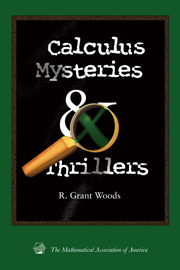An Overview of the Projects
Summary
The order in which the projects appear in this book follows (roughly) the order in which the concepts they utilize are introduced into the typical single variable calculus course. Several projects use a number of different ideas, so this order is of necessity only approximate.
I have assigned seven of the eleven projects to my calculus classes (all but “Calculus for Climatologists,” “Designing Dipsticks,” “Sunken Treasure,” and “The Case of the Alien Agent”). The University of Manitoba is similar to a big American state university, and there is a very large range of ability and preparation among our incoming calculus students. The students in the calculus courses in which I used these projects were probably a random selection from the top 25% of our freshman calculus students. This experience has convinced me that these seven projects are feasible for reasonably bright freshmen working in groups. It has also led to my classification of each as easy, moderate, or difficult. My classifications of the remaining four projects are informed guesses.
Obviously these projects are not particularly accurate descriptions of reality, or of situations in which calculus is actually used. In my experience this does not interfere with their pedagogical value—students accept the projects in the spirit in which they were written. (Occasionally I have included a disclaimer; see "An Income Policy for Mediocria" and "The Case of the Cooling Cadaver.") In fact, one group appended to their solution of "The Case of the Cooling Cadaver" a copy of an article from a medical journal in which the applicability of Newton's Law of Cooling to the recently deceased was refuted and another model was put forth in its place. They then proceeded to use this other model to show that based on the given data, the victim had been murdered several hours before he was last seen alive. Any mathematics project that provokes a response like that should be counted a success.
Information
- Type
- Chapter
- Information
- Calculus Mysteries and Thrillers , pp. xiii - xivPublisher: Mathematical Association of AmericaPrint publication year: 1998
